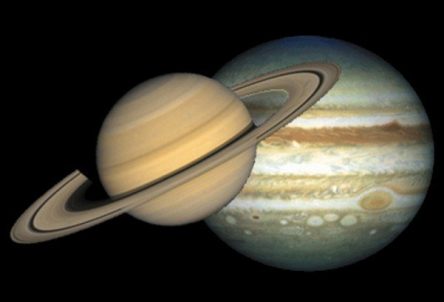 In the context of English grammar, the word “conjunction” refers to certain other words, such as “and”, “yet”, or “but”, that are in turn used to link other words, phrases, and clauses together, but within the parlance of astronomers, the word refers to when two or more celestial objects appear to linkup close and cozy together in the sky. An astronomical conjunction can involve pairings between the moon and bright background stars, the moon and a bright planet, or between two of the 5 naked eye planets themselves (Mercury, Venus, Mars, Jupiter, and Saturn). Conjunctions can also involve the Sun and the inner planets, Mercury and Venus. More often than not, we cannot see these kinds of conjunctions except on those rare occasions when either of these two planets align with the Sun in such a way that we can actually observe them passing across the Sun’s face (known as a “transit”).
In the context of English grammar, the word “conjunction” refers to certain other words, such as “and”, “yet”, or “but”, that are in turn used to link other words, phrases, and clauses together, but within the parlance of astronomers, the word refers to when two or more celestial objects appear to linkup close and cozy together in the sky. An astronomical conjunction can involve pairings between the moon and bright background stars, the moon and a bright planet, or between two of the 5 naked eye planets themselves (Mercury, Venus, Mars, Jupiter, and Saturn). Conjunctions can also involve the Sun and the inner planets, Mercury and Venus. More often than not, we cannot see these kinds of conjunctions except on those rare occasions when either of these two planets align with the Sun in such a way that we can actually observe them passing across the Sun’s face (known as a “transit”).
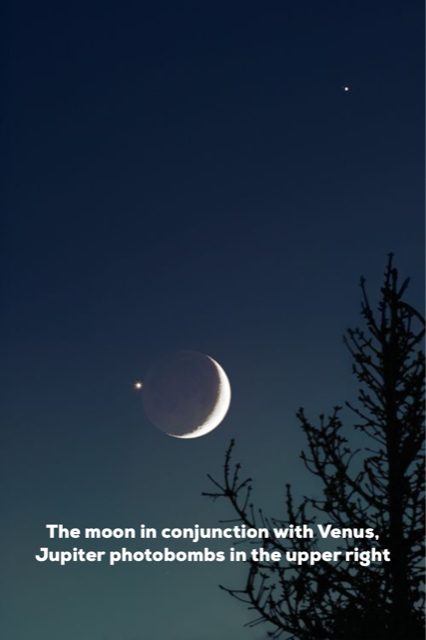 At every new moon, the Sun and the moon are in conjunction and if the alignment is just right, we get a solar eclipse. While conjunctions are not exactly rare, if the pairings involve two bright, night sky objects they can become real attention grabbers, so much so that even people who don’t normally look at the sky can’t help but notice them. On the night of December 21, we get the best conjunction of the entire year as Jupiter and Saturn form a pairing so tight that they will almost appear as a single bright object upon the sky.
At every new moon, the Sun and the moon are in conjunction and if the alignment is just right, we get a solar eclipse. While conjunctions are not exactly rare, if the pairings involve two bright, night sky objects they can become real attention grabbers, so much so that even people who don’t normally look at the sky can’t help but notice them. On the night of December 21, we get the best conjunction of the entire year as Jupiter and Saturn form a pairing so tight that they will almost appear as a single bright object upon the sky.
CONJUNCTION BASICS
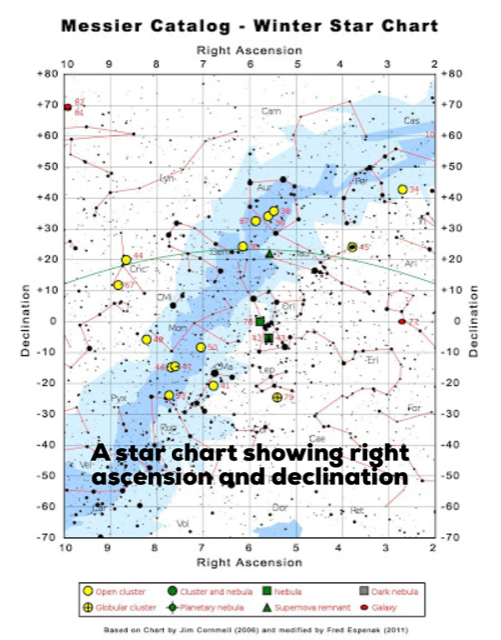 To be perfectly honest, not all of these pairings will fit the strict definition of a conjunction. Over the years, popular astronomy magazines have applied the term to refer to pairings or groupings of objects upon the sky that, while visually striking, don’t always meet the necessary criteria for being a true conjunction. When applying the strict definition of an astronomical conjunction we are referring to the precise moment when two celestial objects share the same right ascension, or RA, upon the sky. In order to map out and locate any object in the sky, astronomers must have an accurate coordinate system much like the one we use here on Earth utilizing longitude and latitude. In fact, the coordinate system used by astronomers is longitude and latitude, only projected onto the sky. RA is analogous to longitude while declination, is analogous to latitude. There are other coordinate systems used by astronomers but this one has the advantage of being completely independent of where on Earth you happen to be observing from or at what time.
To be perfectly honest, not all of these pairings will fit the strict definition of a conjunction. Over the years, popular astronomy magazines have applied the term to refer to pairings or groupings of objects upon the sky that, while visually striking, don’t always meet the necessary criteria for being a true conjunction. When applying the strict definition of an astronomical conjunction we are referring to the precise moment when two celestial objects share the same right ascension, or RA, upon the sky. In order to map out and locate any object in the sky, astronomers must have an accurate coordinate system much like the one we use here on Earth utilizing longitude and latitude. In fact, the coordinate system used by astronomers is longitude and latitude, only projected onto the sky. RA is analogous to longitude while declination, is analogous to latitude. There are other coordinate systems used by astronomers but this one has the advantage of being completely independent of where on Earth you happen to be observing from or at what time.
Okay, for this next bit, it might be helpful if we borrow The Ship of the Imagination from the Cosmos TV series. Oh, don’t worry, I did say “borrow”, we are going to bring it back without even single scratch upon its immaculate paint job. Everyone buckled in? Okay then, let’s go!
We’re here! We haven’t gone very far; I’ve taken us just high enough “above” the solar system so that we can see it all within a single field of view. As we stand here looking “down” upon the solar system you’ll notice that all of the planets are orbiting in a counterclockwise direction around the Sun. Dancing to the tune of the Sun’s gravity, the planets waltz along in their stately and nearly circular orbits. While those orbits may look circular, if we measured their inner dimensions, we would find that they are actually elliptical in shape, an ellipse being something like a somewhat flattened circle (you can really see that in Mars’s and Pluto’s orbital shapes).
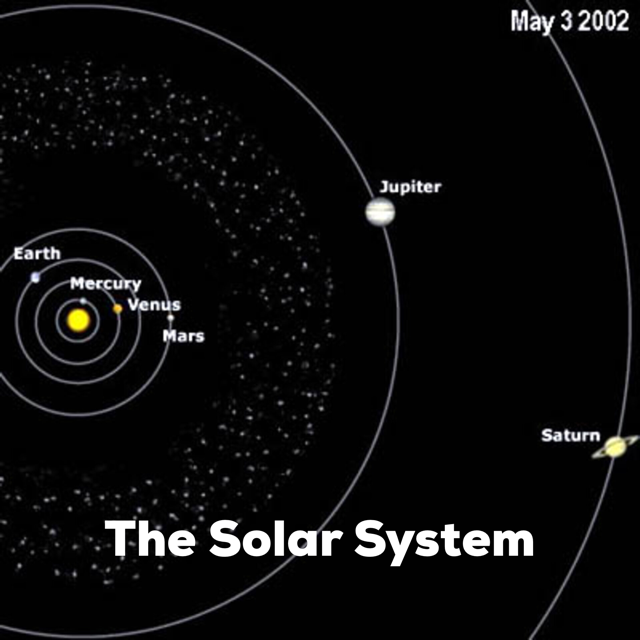 Now, we can’t stay here long enough to see the planets complete one lap each around the Sun, but we can still observe that each one does so at its own particular speed. The innermost planet, Mercury, orbits the fastest and completes one trip around the Sun about every 88 Earth days. The orbital periods for the rest of the planets becomes progressively longer the further you venture out into the solar system. Of course, our year is 365 days long, but by the time you reach Neptune, the year length is 165 Earth years long (you’d be waiting a very long time to see the Times Square ball, drop on New Year’s Eve).
Now, we can’t stay here long enough to see the planets complete one lap each around the Sun, but we can still observe that each one does so at its own particular speed. The innermost planet, Mercury, orbits the fastest and completes one trip around the Sun about every 88 Earth days. The orbital periods for the rest of the planets becomes progressively longer the further you venture out into the solar system. Of course, our year is 365 days long, but by the time you reach Neptune, the year length is 165 Earth years long (you’d be waiting a very long time to see the Times Square ball, drop on New Year’s Eve).
I want to now draw your attention to the planet Jupiter. It’s that really bright one there, just beyond the orbit of Mars (that reddish looking one) and the asteroid belt. Jupiter is moving around the Sun at about 29,320 mph and takes 12 Earth years to complete one trip. The next planet out from Jupiter’s orbit is Saturn, you can see it there as that bright, golden-colored one. Notice how far apart they are. Saturn is more than twice as far from the Earth than is Jupiter! Saturn is so far away in fact that the Sun appears 10 times smaller from there than it does to us here on Earth. Saturn is moving at 21,675 mph and it takes 29 Earth years to make a single trip around the Sun. If you do the math, you will notice that once every 20 Earth years, faster moving Jupiter will pull alongside Saturn in its orbit and as seen from the skies of our home world, they will appear to line up in the sky. We have come to call such Earth perspective alignments between Jupiter and Saturn, “Great Conjunctions” and on the night of December 21 we will get to see one. However, keep in mind that conjunctions really are nothing more than a matter of perspective. It’s not like Jupiter hopped outside of its orbit to get all chummy with Saturn, it just looks like that from our vantage point on the Earth.
What’s that, a question from someone in the back row? I do love questions, that means that I’m in the presence of inquisitive minds, the best kind of mind to have in my opinion. Ah yes, the question is “why do we not see Jupiter pass directly in front of Saturn?” A most excellent question indeed. To answer that it, we are going to use the Ship of the Imagination to gain a different reference point on the solar system, we are going to view it edge on. Fasten your seat belts!
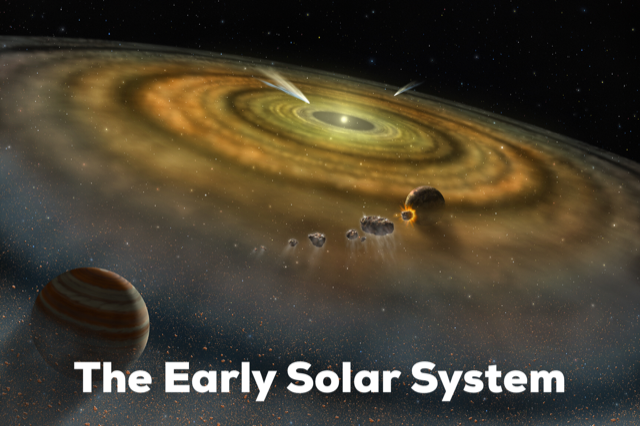 And here we are! Gather around the front viewscreen and take a look. The first thing you will notice is how the planets are all orbiting in the same plane, one that seems to roughly align with Sun’s equator. Oh good, another question! Why do the planets all orbit in the same plane as opposed to being scattered around in various orbits? Well, if I were Neil deGrasse Tyson and we had an unlimited budget, I would take you back in time 4.6 billion years and show you. But times being what they are, I’ll just tell you. If we could go back that far in time, we would see the solar system right before the formation of the Sun and the planets. In its place would be a flattened, pancake cloud of gas and dust and in the center of which the protosun was forming. It began as a vast amorphous cloud, but the cloud underwent collapse. This cloud had some rotation associated with it but as it collapsed, it began to spin faster and faster, flattening itself out into a vast disc. Material from the cloud was pulled in towards the center. As more and more material piled on, the compressing force of gravity made the center very hot and very dense. Eventually, temperatures and pressures became so extreme, that nuclear fusion could occur, and our Sun was born. Over time, the planets began to condense out of that thin disc of material that encircled the infant Sun and that’s why we see all the planets orbiting in the same plane today and why they are all orbiting in the same counterclockwise direction.
And here we are! Gather around the front viewscreen and take a look. The first thing you will notice is how the planets are all orbiting in the same plane, one that seems to roughly align with Sun’s equator. Oh good, another question! Why do the planets all orbit in the same plane as opposed to being scattered around in various orbits? Well, if I were Neil deGrasse Tyson and we had an unlimited budget, I would take you back in time 4.6 billion years and show you. But times being what they are, I’ll just tell you. If we could go back that far in time, we would see the solar system right before the formation of the Sun and the planets. In its place would be a flattened, pancake cloud of gas and dust and in the center of which the protosun was forming. It began as a vast amorphous cloud, but the cloud underwent collapse. This cloud had some rotation associated with it but as it collapsed, it began to spin faster and faster, flattening itself out into a vast disc. Material from the cloud was pulled in towards the center. As more and more material piled on, the compressing force of gravity made the center very hot and very dense. Eventually, temperatures and pressures became so extreme, that nuclear fusion could occur, and our Sun was born. Over time, the planets began to condense out of that thin disc of material that encircled the infant Sun and that’s why we see all the planets orbiting in the same plane today and why they are all orbiting in the same counterclockwise direction.
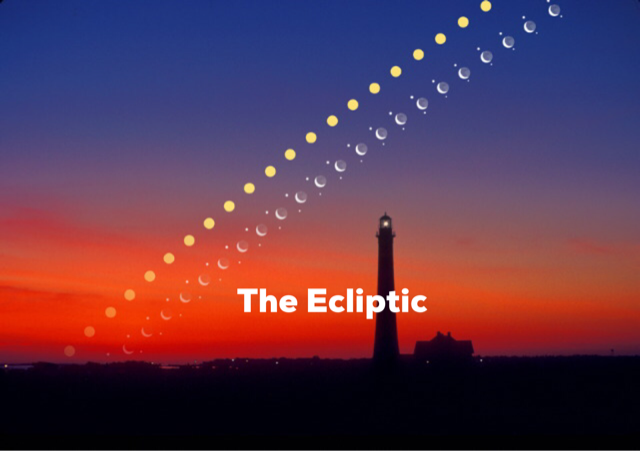 From our vantage point on the Earth, which is right there in the mix with all of the other planets, we are looking out at them from within the plane that we all share by virtue of our collective births 4.5 billion years ago from out of that disc of gas and dust. This plane appears in our sky as the apparent path the Sun makes each year across the sky. We call it the “ecliptic” and it is where we see the moon, planets, eclipses (duh!), and the constellations of the zodiac as well. But look closer at those orbits. You might notice that some of them are tilted a bit with respect to Earth’s orbital plane. Mercury’s orbit is inclined by 7 degrees, Jupiter’s by 1.3 degrees, Saturn’s by 2.5 degrees, and Pluto’s orbit is tilted by some 17 degrees relative to that of Earth’s orbit. The upshot of all of this is that no two conjunctions, particularly of Jupiter and Saturn are ever going to be exactly the same, sometimes they are very close together and at other Great Conjunctions, they are more widely spaced. If they were in exactly the same plane, Jupiter would indeed pass in front of Saturn at every conjunction. Don’t get me wrong, it does happen on very rare occasions when the two line up just right, but don’t expect to see another one of those until the year 7451.
From our vantage point on the Earth, which is right there in the mix with all of the other planets, we are looking out at them from within the plane that we all share by virtue of our collective births 4.5 billion years ago from out of that disc of gas and dust. This plane appears in our sky as the apparent path the Sun makes each year across the sky. We call it the “ecliptic” and it is where we see the moon, planets, eclipses (duh!), and the constellations of the zodiac as well. But look closer at those orbits. You might notice that some of them are tilted a bit with respect to Earth’s orbital plane. Mercury’s orbit is inclined by 7 degrees, Jupiter’s by 1.3 degrees, Saturn’s by 2.5 degrees, and Pluto’s orbit is tilted by some 17 degrees relative to that of Earth’s orbit. The upshot of all of this is that no two conjunctions, particularly of Jupiter and Saturn are ever going to be exactly the same, sometimes they are very close together and at other Great Conjunctions, they are more widely spaced. If they were in exactly the same plane, Jupiter would indeed pass in front of Saturn at every conjunction. Don’t get me wrong, it does happen on very rare occasions when the two line up just right, but don’t expect to see another one of those until the year 7451.
Okay, armed with your newfound knowledge of conjunctions and planetary orbits let’s head back to Earth and get ready for the Great Conjunction of 2020! By the way, if we can all agree not to tell Neil that we borrowed the Ship of the Imagination, I’d greatly appreciate it.
WHEN WORLDS ALIGN
 Throughout the summer of 2020, Jupiter and Saturn have been close together in our night sky but as we headed into autumn, the gap between them has only narrowed more. This will culminate on the night of December 21. But before we get to that night, I want you to begin observing the two planets as often as you can up until showtime. Step outside and face the SW about an hour after sunset and look for the brightest object in that part of the sky, low towards the horizon (you will need an unobstructed view to the SW horizon, especially on the night of the conjunction). That’s Jupiter. Look just to its upper left and you will see the much fainter Saturn. Now, take your index finger and hold it out at arm’s length. The angular width of your index fingertip is about 2 degrees. Hold your extended finger up to the gap in between the two planets. As we get closer to the 21st, step out every night that you can and see just how many fingertips you can squeeze in between Jupiter and Saturn.
Throughout the summer of 2020, Jupiter and Saturn have been close together in our night sky but as we headed into autumn, the gap between them has only narrowed more. This will culminate on the night of December 21. But before we get to that night, I want you to begin observing the two planets as often as you can up until showtime. Step outside and face the SW about an hour after sunset and look for the brightest object in that part of the sky, low towards the horizon (you will need an unobstructed view to the SW horizon, especially on the night of the conjunction). That’s Jupiter. Look just to its upper left and you will see the much fainter Saturn. Now, take your index finger and hold it out at arm’s length. The angular width of your index fingertip is about 2 degrees. Hold your extended finger up to the gap in between the two planets. As we get closer to the 21st, step out every night that you can and see just how many fingertips you can squeeze in between Jupiter and Saturn.
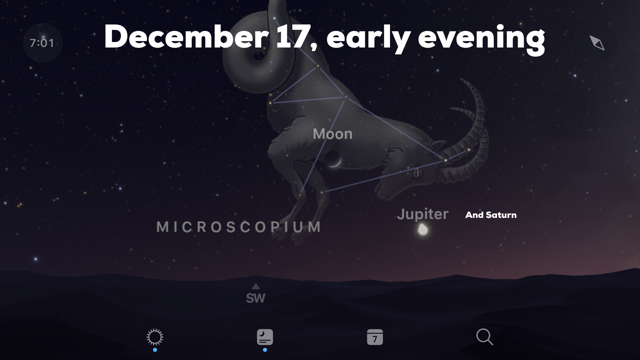 The moon gets in on the act on the night of December 17th when its slender crescent appears off to the left of the two planets. It will be a lovely sight, so try not to miss it if you can.
The moon gets in on the act on the night of December 17th when its slender crescent appears off to the left of the two planets. It will be a lovely sight, so try not to miss it if you can.
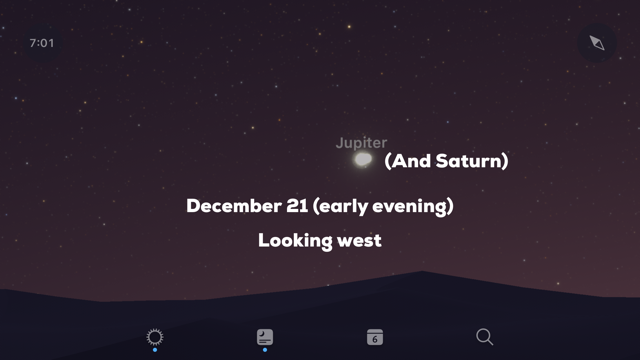 Finally, on the night of the 21st, we get this wonderful pre-Christmas light show, the Great Conjunction of Jupiter and Saturn. As I said earlier, you will need to find a clear, unobstructed view towards the SW horizon. The pair will come into view around 5:18 CST, 20 degrees above the SSW horizon (20 degrees is two fist widths held to arm’s length) but they are going to be caught in the glare of the setting Sun so you will have to know exactly where they are on the sky in order to see them then. I recommend going out at around 6:00 PM in order to see the Great Conjunction, but because they are so low to the horizon, Jupiter and Saturn will set rather quickly. If you don’t catch the conjunction between 6:00 PM and 7:00 PM you are going to miss it because the two worlds will set below the horizon, 2 hours and 20 minutes after sunset at around 7:19 PM CST.
Finally, on the night of the 21st, we get this wonderful pre-Christmas light show, the Great Conjunction of Jupiter and Saturn. As I said earlier, you will need to find a clear, unobstructed view towards the SW horizon. The pair will come into view around 5:18 CST, 20 degrees above the SSW horizon (20 degrees is two fist widths held to arm’s length) but they are going to be caught in the glare of the setting Sun so you will have to know exactly where they are on the sky in order to see them then. I recommend going out at around 6:00 PM in order to see the Great Conjunction, but because they are so low to the horizon, Jupiter and Saturn will set rather quickly. If you don’t catch the conjunction between 6:00 PM and 7:00 PM you are going to miss it because the two worlds will set below the horizon, 2 hours and 20 minutes after sunset at around 7:19 PM CST.
 On the night of the Great Conjunction, Jupiter and Saturn will be separated by only 1/10th of one degree, or 6.1 arc minutes. That’s so tight of a pairing that you might have trouble splitting the two apart, although it is more than likely that most of us with good eyesight will probably be able to do so. But to put this into some kind of perspective, go out the next clear night and face north to find the Big Dipper. Locate the star in the middle of the dipper’s handle, this is Mizar. Mizar is actually a double star and most of us can see its companion, Alcor (if only barely). The angular distance between the two stars is 11.8 arc minutes. Now you have a better feel for what to expect on the night of the 21st with the Jupiter and Saturn. If you have difficulty seeing them as two distinct objects, use binoculars or a small telescope to observe with. In fact, I urge you to use a small scope if you have one, you don’t often get a chance to see these two worlds together like this in a single field of view. But don’t expect crystal clear images with lots of fine detail. Whenever you look at objects so close to the horizon, you are having to look through much thicker atmosphere than you would if the objects detail. Still, you should be able to see the rings of Saturn and some of the more prominent belts of Jupiter as well as the larger moons that orbit the two planets.
On the night of the Great Conjunction, Jupiter and Saturn will be separated by only 1/10th of one degree, or 6.1 arc minutes. That’s so tight of a pairing that you might have trouble splitting the two apart, although it is more than likely that most of us with good eyesight will probably be able to do so. But to put this into some kind of perspective, go out the next clear night and face north to find the Big Dipper. Locate the star in the middle of the dipper’s handle, this is Mizar. Mizar is actually a double star and most of us can see its companion, Alcor (if only barely). The angular distance between the two stars is 11.8 arc minutes. Now you have a better feel for what to expect on the night of the 21st with the Jupiter and Saturn. If you have difficulty seeing them as two distinct objects, use binoculars or a small telescope to observe with. In fact, I urge you to use a small scope if you have one, you don’t often get a chance to see these two worlds together like this in a single field of view. But don’t expect crystal clear images with lots of fine detail. Whenever you look at objects so close to the horizon, you are having to look through much thicker atmosphere than you would if the objects detail. Still, you should be able to see the rings of Saturn and some of the more prominent belts of Jupiter as well as the larger moons that orbit the two planets.
If you miss out on this Great Conjunction there won’t be another until the year 2040, and the two planets will not be as close as they are this time, in fact, they have not been this close since the year 1623. Oh, by the way, the 21st also happens to be the date of the northern hemisphere winter solstice, what a coincidence that the longest night of the year should begin with a such a bright display of celestial light.
Happy Holidays to you all! Stay safe and may you have many clear, dark skies in 2021.